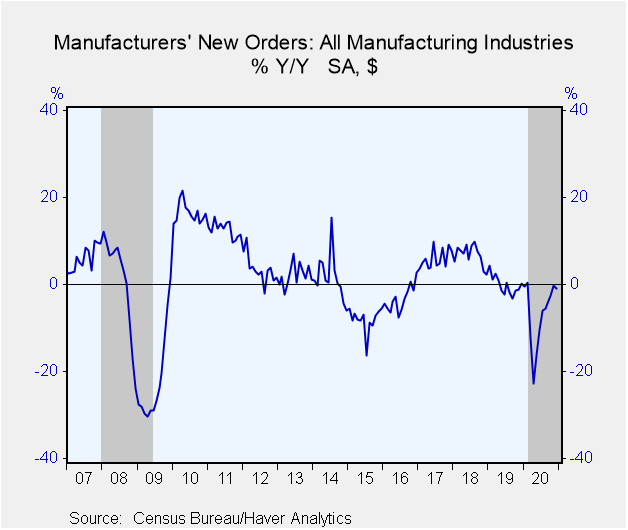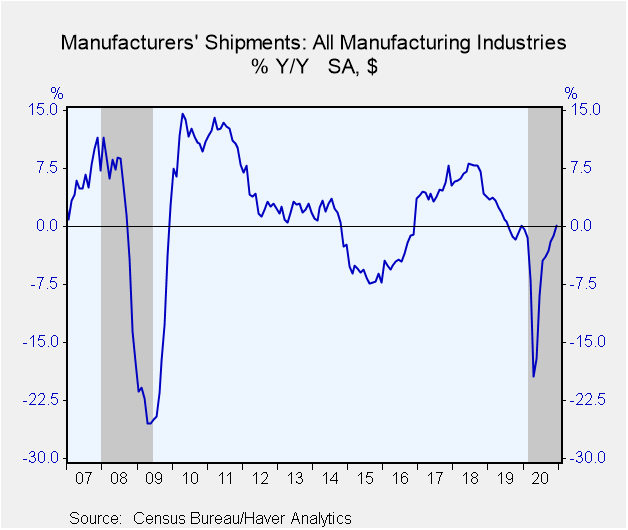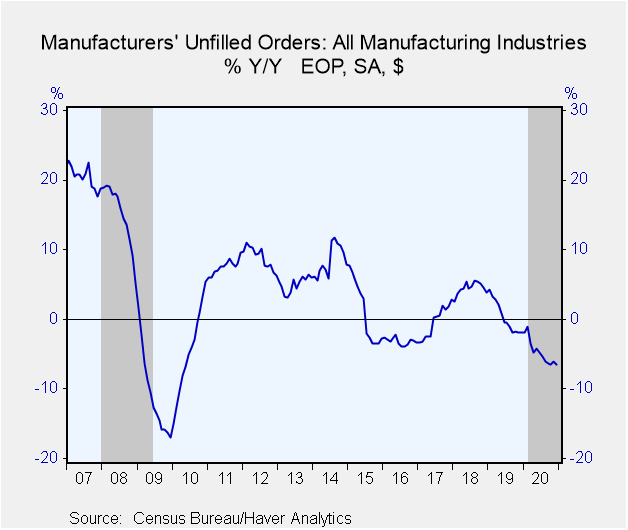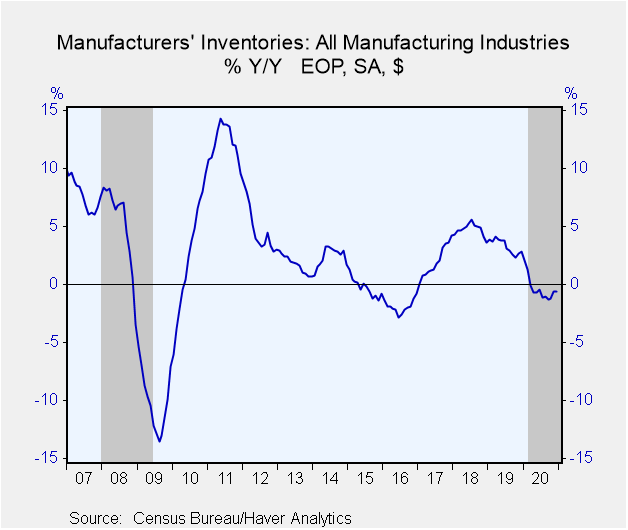 Global| Feb 04 2021
Global| Feb 04 2021U.S. Factory Orders & Shipments Increase During December
by:Tom Moeller
|in:Economy in Brief
Summary
• Factory orders have risen in each month since May 2020. • Inventory accumulation continues. • Order backlogs decline further. Manufacturing activity continues to strengthen. Factory orders rose in December for an eighth consecutive [...]
• Factory orders have risen in each month since May 2020.
• Inventory accumulation continues.
• Order backlogs decline further.
Manufacturing activity continues to strengthen. Factory orders rose in December for an eighth consecutive month. The 1.1% gain (-0.8% y/y) followed a 1.3% November rise, revised from 1.0%. A 0.7% December increase had been expected in the Action Economics Forecast Survey.
Durable goods orders rose 0.5% (1.9% y/y), which was revised from the 0.2% gain reported last week. Transportation sector orders eased 0.8% (-7.6% y/y) as nondefense aircraft orders fell sharply. Machinery orders strengthened 2.7% (6.5% y/y) while electrical equipment & appliance orders gained 0.7% (1.9% y/y). The full report on durable goods activity is available here.
Nondurable goods orders, which equal shipments, surged 1.7% (-3.4% y/y) after rising 1.2% during November. Shipments from petroleum refineries surged 6.3% (-24.6% y/y) as oil prices remained strong. Among other nondurable goods sectors, basic chemical shipments rose 0.6% (3.8% y/y) while paper product shipments gained 0.4% (3.7% y/y). Textile mill shipments improved 0.6% (-1.1% y/y) while apparel shipments surged 8.8% (3.4% y/y).
Shipments of durable goods improved 1.7% in December (3.7% y/y) following a 0.4% November improvement. Transportation product shipments rose 3.1% (1.9% y/y) as nondefense aircraft shipments rebounded 44.6% (-38.6% y/y) after falling 30.9%. Shipments of computers & electronic products improved 0.6% (8.7% y/y).
Inventories of manufactured products rose 0.3% in December (-0.6% y/y). Durable goods inventories eased 0.2% (+0.6% y/y) while nondurable goods inventories strengthened 1.1% (-2.4% y/y). The value of petroleum refinery inventories surged for the second straight month, up 4.9% (-19.9% y/y) while textile mill inventories gained 1.4% (-4.1% y/y). Food product inventories rose 1.0% (0.3% y/y) and basic chemical inventories gained 0.8% (1.7% y/y).
Unfilled orders eased 0.3% in December (-6.4% y/y) and have been falling since early last year. Durable goods backlogs declined 0.3% (-6.4% y/y) as unfilled orders in the transportation sector fell 1.0% (-11.0% y/y). This decline was offset by a 1.9% rise (8.9% y/y) in unfilled orders for electrical equipment & appliances.
The factory sector figures and West Texas intermediate oil prices are available in Haver's USECON database.
| 56Factory Sector (% chg) - NAICS Classification | Dec | Nov | Oct | Dec Y/Y | 2020 | 2019 | 2018 |
|---|---|---|---|---|---|---|---|
| New Orders | 1.1 | 1.3 | 1.3 | -0.8 | -6.7 | -0.1 | 6.8 |
| Shipments | 1.7 | 0.8 | 1.2 | 0.1 | -5.7 | 1.0 | 6.6 |
| Unfilled Orders | -0.3 | -0.0 | -0.2 | -6.4 | -6.4 | -1.8 | 3.9 |
| Inventories | 0.3 | 0.8 | 0.3 | -0.6 | -0.6 | 2.8 | 3.6 |
Tom Moeller
AuthorMore in Author Profile »Prior to joining Haver Analytics in 2000, Mr. Moeller worked as the Economist at Chancellor Capital Management from 1985 to 1999. There, he developed comprehensive economic forecasts and interpreted economic data for equity and fixed income portfolio managers. Also at Chancellor, Mr. Moeller worked as an equity analyst and was responsible for researching and rating companies in the economically sensitive automobile and housing industries for investment in Chancellor’s equity portfolio. Prior to joining Chancellor, Mr. Moeller was an Economist at Citibank from 1979 to 1984. He also analyzed pricing behavior in the metals industry for the Council on Wage and Price Stability in Washington, D.C. In 1999, Mr. Moeller received the award for most accurate forecast from the Forecasters' Club of New York. From 1990 to 1992 he was President of the New York Association for Business Economists. Mr. Moeller earned an M.B.A. in Finance from Fordham University, where he graduated in 1987. He holds a Bachelor of Arts in Economics from George Washington University.










